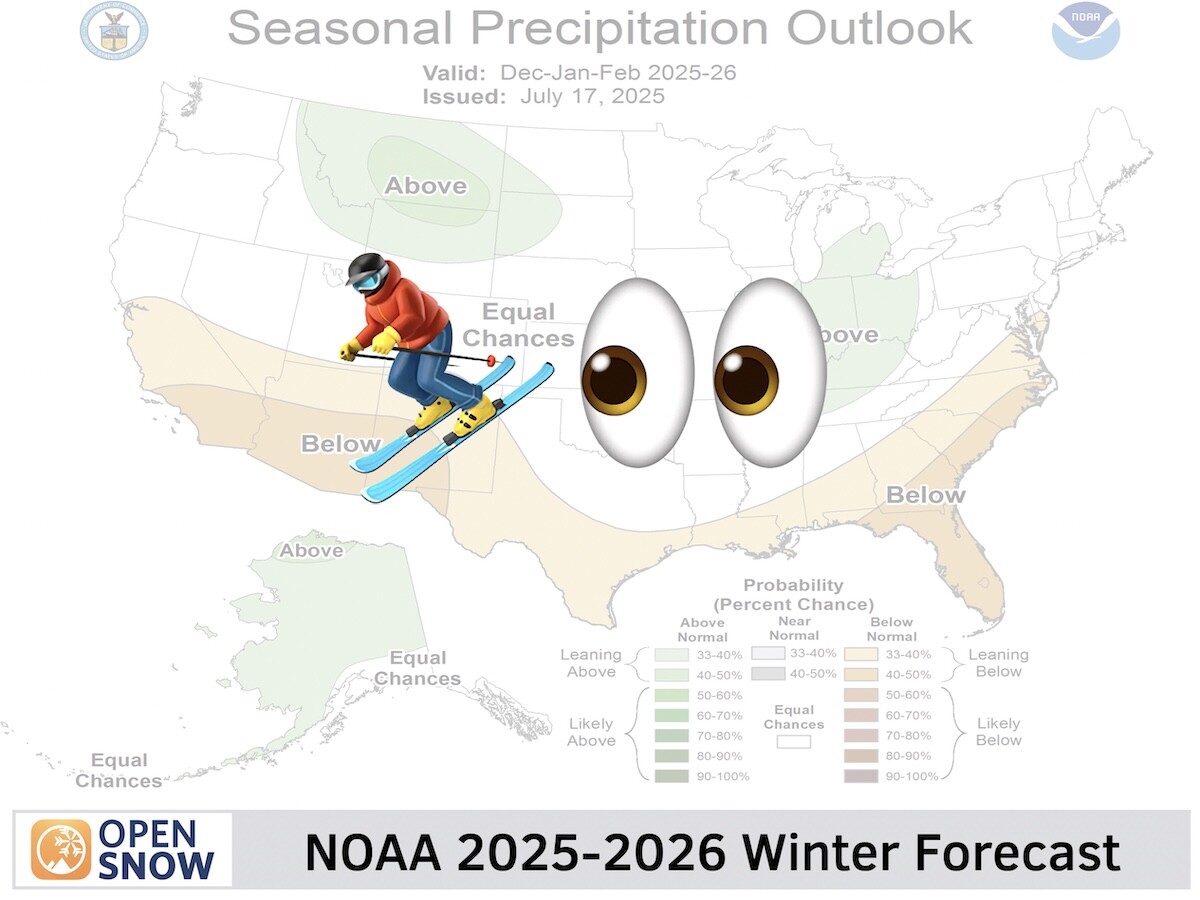News

By Bob Ambrose, Forecaster Posted 9 months ago October 24, 2024
2024-2025 Alberta & Canadian Rockies Winter Forecast Preview
In this first post of the new season, we’ll try to understand what we may expect this winter. A weak La Nina condition looks likely, with oceanic readings showing slightly cooler temps. OpenSnow has identified six weak La Nina Winters over the past 30 years, from which I will pull historic data from snow survey sites closest to popular ski resorts in Alberta.
Before we look ahead to Alberta’s 2024-2025 winter season forecast, it's important to remember that any winter outlook will contain an inherent degree of uncertainty. However, thanks to the available historical weather data, there are a few clues that we can keep an eye on.
Long-range forecasts are rarely accurate. These forecasts cover 3-6 months, but we know that skiing quality improves and degrades with storm cycles that last a few days to a week.
La Nina, Explained
La Niña refers to the large-scale ocean-atmosphere climate phenomenon linked to periodic cooling in sea-surface temperatures across the central and east-central equatorial Pacific.
La Niña represents the cool phase of the ENSO cycle and means that the ocean water temperatures are cooler than average.

La Nina Forecast for the Winter of 2014-2025
"ENSO Neutral" conditions (neither La Niña nor El Niño) have persisted through the summer of 2024 and long-range models have been projecting a higher-than-average chance of a La Niña taking over during the winter of 2024-2025.

The weekly Nino-3.4 region index (sea surface temperatures in the east-central Pacific) anomaly has dropped from 1.8°C during the 2023-2024 winter season to -0.29°C as of October 22, 2024.
A similar change from El Niño to a weak La Niña last occurred ahead of the 2016-2017 winter season.
Thanks to OpenSnow meteorologist Alan Smith, we have identified six winters since 1990 in which weak La Niña conditions were present:
- 2000-2001
- 2005-2006
- 2008-2009
- 2016-2017
- 2017-2018
- 2022-2023
We will use these winter seasons that featured a weak La Niña as “analog” years and pull snowfall and SWE and snowfall data for this analysis. Please note that the availability of snow survey sites to pull historical data was a challenge, and I apologize for not including Norquay and Nakiska. For Castle Mountain, I used historical snowfall data from the resort from the 2016/17, 2017/18, and 2022/23 winters as prior data was not available.
Historical Weak La Nina Seasons at Banff/Sunshine Village and Lake Louise Ski Resort

Image courtesy Banff/Sunshine/R.Krabbe

Image courtesy/Lake Louise/ R.Krabbe
OpenSnow researched the six most recent weak La Nina years and compared them against the 30-year median snow water equivalent (SWE) of 714mm on March 31 at the Floe Lake Snow Survey Site, located at 2100 meters, 27 kilometers west of Banff/ Sunshine, and 55 kilometers southwest of Lake Louise Resort (the closest site with available data). We found that the median SWE at the survey site during those six La Nina years was 602 mm/23.7” on March 31, or 84%, compared to the 30-year median of 714 mm/28.1”.
SWE on March 31 During Weak La Nina years
30-Year Normal: 714 mm (28.1”)
2000-2001: 397 mm/15.6” (56%)
2005-2006: 608 mm/24.0” (85%)
2008-2009: 596 mm/23.5” (84%)
2016-2017: 842 mm/33.15” (118%)
2017-2018: 818 mm/32.2” (115%)
2022-2023: 536 mm/21.1” (75%)
For timing, when looking at the change in SWE each month during those years and comparing them against the 30-year median change in SWE for that month:
November: 97 mm/3.82” (65%)
December: 92 mm/3.62” (85%)
January: 85 mm/3.34” (68%)
February: 117 mm/4.61” (105%)
March: 99 mm/3.90” (68%)
April: 109 mm/4.30” (92%)
Looking at all the numbers above with the understanding that the winter of 2016/17 best resembles the cool oceanic readings we are currently seeing, I am a tad more optimistic than the 84% of median SWE six weak La Nina winter figures mentioned earlier.
2016/17 was a stellar year at these SkiBig3 resorts. Sunshine Village brought in 770 cm (303”), 106% of average, and Lake Louise 580 cm (228”) or 121% of average. This pretty much matches up with the 118% SWE from the Floe Lake survey site. Surface temperatures also corresponded to generally below-average readings from late December through the end of March.
Looking at the monthly data, January stands out as being the driest after a slightly below-average start to the season. The probabilities grew to slightly above-average snowfall in February, with a dip in March, picking back up in April.
Could we see a rerun of 2016/17’s above-average snowfall in 2024/25? I’m optimistic…but the caveat is that it’s just a scientific guess.
Historical Weak La Nina Seasons at Marmot Basin

Webcam image of Marmot Basin's expansive alpine terrain
OpenSnow researched the six most recent weak La Nina years and compared them against the 30-year median snow water equivalent (SWE) of 542 mm on March 31 at the Yellowhead Lake Snow Survey Site, located at 1860 meters, 35 kilometers west of Marmot Basin (the closest site with available data). We found that the median SWE at the survey site during those six La Nina years was 425 mm/16.7” on March 31, or 78%, compared to the 30-year normal of 542 mm/21.34”.
SWE on March 31 During Weak La Nina years
30-Year Normal: 542 mm/21.34”
2000-2001: 345 mm/13.6” (64%)
2005-2006: 454 mm/17.9” (84%)
2008-2009: 465 mm/18.3” (86%)
2016-2017: 395 mm/15.6” (78%)
2017-2018: 552 mm/21.7” (102%)
2022-2023: 369 mm/14.5” (68%)
For timing, when looking at the change in SWE each month during those years and comparing them against the 30-year median change in SWE for that month:
November: 88 mm/3.5” (73%)
December: 62 mm/2.4” (78%)
January: 51 mm/2.0” (44%)
February: 67 mm/2.6” (99%)
March: 69 mm/2.7” (64%)
April: 36 mm/1.4” (104%)
Of the six weak La Nina winters studied, the winter of 2016/17 looks to match up best with the latest readings we are seeing from the equatorial Pacific and the current La Nina winter forecast. At Marmot Basin Resort, 472 cm (186”) fell during the 2016/17 season, or 107% of their seasonal average, which is 440 cm (173”).
Although the SWE (which measures water content in the snow) on March 31, 2017, was only 78% of the 30-year mark at the snow survey site at Yellowhead Lake, it tells me that the snowpack that season was ‘drier,’ this due to colder than average temperatures that brought high dendritic (powdery) dry snow. Marmot is the northernmost major resort in Alberta and its winter temperatures are always a few degrees colder than points south.
The monthly SWE statistics show the snowfall starting just below average in the early season, followed by a semi-dry January, with a quick rebound in February and again in April. Historically, Marmot is prone to late-season storms/cold fronts that sweep in from the northeast, and the stats above likely reflect those tendencies.
After a brutal summer of devastating fires and smoke, could there be a glimmer of hope for a stellar winter season in Jasper/Marmot Basin? The indicators are there, and all of us will be doing our funky snow dances and bonfire sacrifices for a powdery winter for the brethren up north.
Historical Weak La Nina Seasons Castle Mountain Resort

Image courtesy of Castle Mountain Resort
Arguably the snowiest resort in the Alberta Rockies, Castle Mountain sits next to the Continental Divide just north of the US border. Its east/northeast exposure works well when prevailing storms come out of the west/southwest.
Unfortunately, the closest snow survey site of Gardiner Creek does not reveal historic SWE data, so instead, we will look at the end of the season (generally the 10th of April) cumulative snowfall at Castle. The resort had historical numbers back to 2016, so we can look at the three most recent weak La Nina winters of 2016/17, 2017/18, and 2022/23 for any clues for the upcoming winter.
Cumulative Seasonal Snowfall
Average Seasonal Snowfall 850 cm/335"
2016/2017 978 cm (385”), 115% of average
2017/2018 1165 cm (459”) 137% of average
2022/2023 732 cm (288”) 86% of average
The three latest weak La Nina winters average out to 113% of average cumulative seasonal snowfall at Castle Mountain Resort.
I have been forecasting the Alberta Rockies since 2019, and I do remember that the Rockies had widespread below-average snowpack during the winter of 2022/23, with Castle ending the season with the deepest snowpack of all the Alberta Resorts at 86% of average.
That said, the winter of 2016/17 has been identified as the closest to where we are currently with La Nina readings and the weak La Nina forecast for the 2024/25 winter. That year, Castle ended up the season at 115% of average snowpack, but I unfortunately do not have monthly snowfall stats from that season. So, I researched monthly temperature/snowfall trends from the closest incorporated township of Pincher Creek (37 km NE) to try to find some clues.
As you can see in the temperature graph below, it was a colder-than-average winter overall. The spikes downward represent below-average temps that were plentiful in late December, through most of February, and through the first half of March. These dips in temperature represent cold fronts, and most of the time, cold fronts bring snow. You can see this correlation in the ‘monthly weather at Pincher Creek’ graph below.


Graphics courtesy of WeatherSpark.com
Take this information any way you want, but I am cautiously optimistic for an above-average upcoming winter season at Castle Mountain.

Having said all of this, for skiers and snowboarders, keep in mind that when it comes to finding the best conditions, it’s all about timing. To have the best chance of enjoying the deepest powder, our recommendation is to book a trip 7-10 days in advance.
Sometimes, longer-range forecasts can identify possible storms 1-2 weeks (or longer) in advance, but often, forecast confidence in the details of each storm only begins to increase when the system is about one week away or closer.
Every OpenSnow All-Access account provides 10-day snow forecasts, expert analysis from local forecasters, 3D weather maps, and custom snow alerts to help you find the deepest snow and the best conditions all winter long.

Thanks for reading! Let’s start doing our pre-winter rituals for a bountiful 2024/25 winter up and down the Alberta Rockies. Stay tuned for my regular Canadian Rockies Daily Snow updates starting in early November. Until then,
Powder Out!
Bob Ambrose
About The Author




